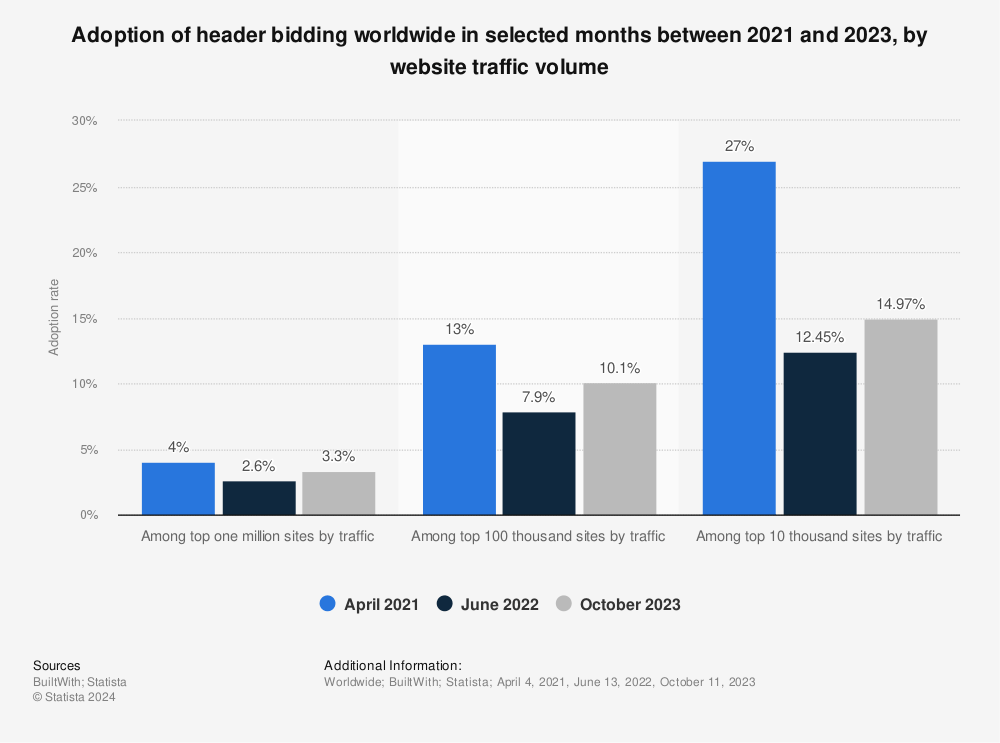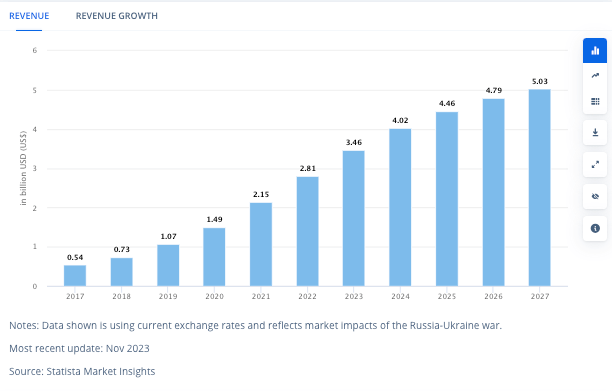10 Main AdTech Trends Publishers Need to Know
The landscape of advertising technology (adtech) has seen unprecedented growth, fundamentally transforming the advertising sector over the past three decades. Giants like Google and Facebook have leveraged ad innovations to generate significant revenue, and countless independent adtech companies became prominent names in households worldwide.
This article delves deep into adtech, outlining its benefits and showcasing ten booming adtech trends shaping the industry in 2024.
What is AdTech?
Adtech is a catch-all phrase that refers to a wide range of software platforms and tools for creating and presenting targeted advertisements to prospective clients. Advertisers gather a wide range of audience data, identify the target audience, set targeting criteria, and assess the campaign’s return on investment using advertising technologies.
Advertising technologies enable the personalization of advertising messages and display ads to interested audiences precisely when they are most responsive to them.
One of the best examples of such technology can be header bidding. Publishers use the sophisticated programmatic approach of header bidding, sometimes referred to as advance bidding or pre-bidding, to offer inventory to several ad exchanges at once before making calls to their ad servers. According to Statista, 14.97% of the websites used header bidding as a component of their ad technology stack in 2023.

Source: Statista
The Role of AdTech in Boosting the Needed Products Through Digital Media
The main objectives of adtech are to improve the efficacy of advertising channels, analyze target audiences, manage ads, and distribute ads.
Technologies used in advertising technology are intended to:
- help publishers (owners of advertising space) sell impressions at the best price (e.g., header bidding);
- assist advertisers and advertising agencies in designing, customizing, measuring, and managing advertising campaigns to maximize return on investment (Agency Trading Desk);
- make it easier to match publisher supply and advertiser demand across ad networks (SSPs, DSPs).
Main Pros of AdTech Development Services
Digital advertising campaigns are more accessible and more effective thanks to adtech. Thanks to recent breakthroughs like machine learning, processing massive volumes of data is no longer a barrier. The expansion of programmatic advertising and video as a digital advertising format serves as more proof of this.
- Improved monitoring of the campaign
Adtech development services have given demand partners better planning and measuring options, strengthening them. Adtech products, such as ad servers, show campaign effectiveness from various angles and specify where and how the ads perform. Productivity rises, as a result, making media buying easier and faster, and eliminating the human factor.
- Audience division
The “one-ad-fits-all” strategy is useless, according to professionals in marketing. Brand customers could be in different marketing funnel stages, requiring various strategies. Ad technology makes it simpler to serve various advertising to diverse audiences.
- More effective use of advertising funds
Media buyers can offer ads that resonate with a target demographic at the correct moment and are more likely to result in a conversion, thanks to the insights supplied by adtech. For example, the CMP tool effortlessly obtains users’ consent by gathering and storing visitor privacy preferences.
Spheres AdTech Experts are Competent In
Advertising technology is constantly evolving, and adtech devs are setting up smart automated solutions that bring the most effective results.
- Artificial intelligence and machine learning. Consumer data is read and analyzed by algorithms created by adtech programmers, enabling you to fine-tune your targeting and choose pertinent advertising content. Based on computer vision, the content environment is analyzed.
- Big Data. Since analytics are helpful at every point in the sales process, most advertisers allocate money to big data, also with the help of adtech consulting.
- Interactive and gamification. Gamification has grown commonplace in practically all spheres of life, including advertising, as entertainment content is extremely well-liked by customers. Over the course of the projected period (2022-2027), the worldwide gamification industry is anticipated to see a CAGR of 26.5%.
- Personalization and automation of creatives. For instance, it is anticipated that software for customer experience personalization and optimization will generate more than $9 billion in global revenue by 2023. Although the percentage of marketing budgets allocated to personalization can vary, most businesses already commit more than 50% of their expenses to this endeavor.
10 AdTech Technology Trends
1. Podcast Ads
It is estimated that podcast revenue will surpass $4 billion by 2024. So, it’s a great time to be in podcasting.
The privacy changes in the adtech sector impact mobile device IDs and third-party cookies but have no immediate impact on podcasting. Thanks to this, the CPM prices are increasing.
Podcast advertising CPMs have also seen a notable increase, reflecting the medium’s growing appeal. A significant factor behind this rise is the medium’s resilience to privacy changes affecting digital advertising, making it a stable and lucrative channel.

Source: Statista
2. In-game advertising
A possible new area of growth for programmatic is in-game advertising, particularly with the emergence of native in-game advertising. The Interactive Advertising Bureau (IAB) has amended its rules for intrinsic in-game advertising, sometimes referred to as in-gameplay or native in-game advertising, for the first time since 2009.
Newzoo’s Global Games Market Report suggests that the global games market will generate $159.3 billion in revenue in 2020, with in-game advertising comprising a significant portion of this revenue.
Integrating game mechanics into ads increases engagement, interaction, and brand recall, offering a dynamic and immersive experience.
3. DOOH
In 2022, 76% of companies worldwide raised DOOH advertising budgets. DOOH advertising is gaining momentum, driven by advancements in technology and increased advertiser interest in reaching consumers outside their homes in innovative ways.
According to the Out of Home Advertising Association of America, digital OOH continues to be the biggest growth driver with 9.8%.
4. Retail media programmatic networks
The use of programmatic advertising by retail media networks is on the rise. For omnichannel reach in retail campaigns, retail media inventory is linked to off-site properties and third-party media.
Retail media networks are increasingly leveraging programmatic technology to offer advertisers precision targeting and efficiency, bridging the gap between digital advertising and physical retail environments.
According to a report by the Boston Consulting Group (BCG), spending on retail media networks is expected to reach $100 billion by 2026, highlighting the rapid growth of this trend.
5. First-party data
With the deprecation of third-party cookies underway, advertisers and publishers are shifting towards first-party data strategies to maintain targeting and measurement capabilities.
A survey by Digiday indicates that 85% of advertisers and 79% of publishers are prioritizing first-party data strategies ahead of the cookie phase-out.
6. Connected TV (CTV)
There’s been a significant shift from traditional TV to streaming services, with more consumers favoring on-demand content over scheduled programming. This transition expands the reach of CTV advertising, making it a crucial platform for advertisers.
CTV advertising is typically thought of as being challenging to measure. However, linked TV advertisements may be tracked with precision virtually on par with other digital channels with the correct software stack and integrations.
Measurement capabilities for Connected TV (CTV) advertising are also improving, allowing advertisers to track and optimize their CTV campaigns with greater accuracy and insight.
Forecast shows that CTV advertising spending in the US will exceed $25 billion in 2023, emphasizing the need for sophisticated measurement tools.
Source: eMarketer
7. Supply chain transparency
The OpenRTB 2.6 (a communication protocol that enables real-time bidding and addressable advertising) is now in use, and both the supply and demand sides benefit from the new version’s increased flexibility, particularly in the CTV and contextual advertising.
The introduction of OpenRTB 2.6 aims to enhance transparency and flexibility in the programmatic advertising ecosystem, particularly benefiting sectors like CTV and contextual advertising.
That goes in line with the continuous development of industry-wide solutions such as ads.txt and sellers.json, and SupplyChain Object, all designed to provide a clear view of the digital advertising supply chain.
The supply path optimization (SPO) also stands as a linchpin strategy for advertisers, while publishers are becoming increasingly more interested in gaining control over their advertising operations, cutting down the intermediaries, which is evident in the rise of self-serve advertising platforms.

8. Vernacularization
Tailoring ads to local languages and cultures significantly improves engagement and conversions, tapping into the emotional resonance of the audience.
A study by Common Sense Advisory found that 75% of consumers prefer to buy products in their native language, underlining the importance of vernacular advertising.
9. Identity solutions
The industry is exploring new identity solutions, such as unified ID systems, to navigate the post-cookie landscape while ensuring privacy and personalization.
A report by The Trade Desk reveals that almost 90% of U.S. marketers deem the importance of finding an alternative to third-party cookies as critical, while Quantcast reports that more than 80 identity solutions already exist today.
10. AI and ML
AI and machine learning are being used to deliver highly personalized ad experiences, significantly enhancing consumer engagement and loyalty.
Salesforce’s State of the Connected Customer report indicates that 52% of consumers expect offers to always be personalized, highlighting the demand for hyper-personalization in advertising.
Conclusion
Advertisers and publishers are already utilizing AI and ML data analysis, programmatic TV or podcast advertising, and DOOH based on mobile location as the future of advertising technology.
The adtech toolbox elevates advertising efforts, creating a win-win situation for advertisers and publishers. Advertisers integrate the complete toolkit into a single system with advertising technology for more effective strategic planning and advertising management. Publishers benefit from more relevant advertising, higher prices, and better demand for their ad inventory.


